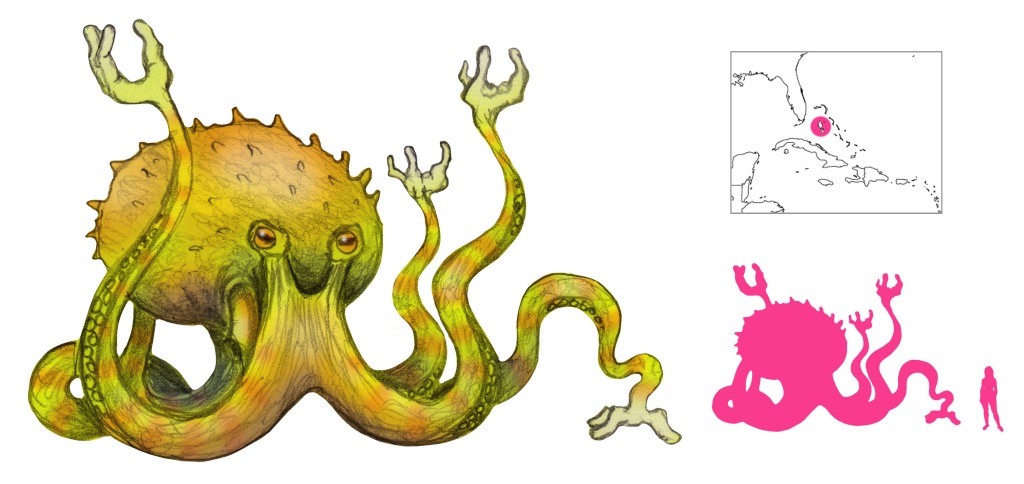Variations: Giant Scuttle, Him of the Hands

Off the shores of Andros Island in the Bahamas are the blue holes. These are deep submarine caves that appear as dark “holes” in the sea. Local lore claims that they are bottomless, and while it may be safe to sail over them, diving is perilous. The Lusca embodies the terror of these dark places and personifies their dangerous currents. The blue holes are littered with the skeletons of its victims and the wreckage of boats and outboard motors.
A lusca is a gigantic octopus or cuttlefish, sometimes said to be half octopus and half dragon. It is also known as a “giant scuttle”, where “scuttle” is the Bahamian term for octopus, and “Him of the Hands”, although it is unclear whether those are actual hands or merely a reference to cephalopod arms. Those arms can reach up to 75 feet (roughly 23 meters) long. They are dangerous because they can grab a boat or a fisherman from one end and anchor themselves to the bottom on the other; if they cannot make fast to the seafloor, they cannot pull their prey down.
The lusca shoots its “hands” out of the water to snatch anyone or anything that comes too close to a blue hole. A lusca can stop a two-master dead in the water, coiling its tentacles around the rudder while its “hands” reach up and feel around the deck. The moment the tentacles contact a human, they immediately pull the unfortunate sailor into the water.
George J. Benjamin and Jacques-Yves Cousteau were both warned of the dangers of the lusca, but failed to find any trace of the giant octopus. In fact, Benjamin succeeded in retrieving an outboard motor supposedly lost to a lusca, much to the bemusement of the motor’s proprietor.
Wood and Gennaro identify the St. Augustine blob, found on a Florida beach, as being the same animal as the lusca. As the blob was found to be a mass of connective tissue from a large vertebrate, probably a whale, this is unlikely.
References
Benjamin, G. J. (1970) Diving into the Blue Holes of the Bahamas. National Geographic, 138(3), pp. 347-363.
Cousteau, J. and Diolé, P. (1973) Trois Aventures de la Calypso. Flammarion.
Fodor, E. (1981) Fodor’s Caribbean and the Bahamas. Hodder and Stoughton, London.
Naish, D. (2016) Hunting Monsters: Cryptozoology and the Reality Behind the Myths. Arcturus, London.
Wood, F. G. and Gennaro, J. F. (1971) An Octopus Trilogy. Natural History, LXXX(3), pp. 15-24 and 84-87.
Looks like a Dr. Suess beast
LikeLiked by 1 person
That’s a compliment!
LikeLiked by 1 person
Imagine if someone survived being on a boat when it was attacked by a kraken so they decided to try to assuage their trauma with a vacation to the Caribbean only to have their boat attacked by a lusca. He survives again and decides to try another vacation in Japan but his boat gets attacked by Akkorokamui. Every sea he goes to he ends up getting attacked by the lpcal mythic cephalopods when one day he’s just had enough.
“That’s it! No more sailing on the sea. Where’s a good place that’s landlocked? I know! Oklahoma!”
The very second his boat sails from his summerhouse down by the water he gets wrecked by a lake octopus.
LikeLiked by 2 people
Cephalopods are scary
LikeLike
Brings up a good question. So what’s with those freshwater octopuses in Oklahoma? The only “sighting” I know of is that time a boy was drowning in a lake and when rescuers tried to help him he was saying that something was trying to pull him under
LikeLiked by 1 person
Presumably anything that tries to pull someone under becomes an octopus because we’re conditioned to be that afraid of octopuses?
LikeLike
And then he when he finally has enough, quits sailing, and moves far away to a forest with no lake or river or ocean at sight he then gets attacked by a Tree Octopus.
LikeLiked by 1 person
As far as I know, Akkorokamui is benevolent.
LikeLiked by 1 person
http://yokai.com/akkorokamui/
A yokai lore expert disagrees with that
LikeLiked by 1 person
But I suspect He is probably friendlier after He is given some offerings. Always good to pay respect to the powers of nature
LikeLiked by 1 person
Curiousity. Is Lusca’s more “sharktopus”-like depiction also in actual folklore or does it come from the popular culture like manticore having wings?
LikeLiked by 1 person
I suspect it’s a pop culture addition. As far as I can tell it’s a giant octopus but more recent sources seem to add shark elements.
LikeLike
Do you know where the strange Sharktopus depictions infesting image searches for ‘Lusca’ are coming from?
LikeLiked by 1 person
More recent sources seem to mix in shark elements. Not sure where those come from. Also memes are stronger than facts.
LikeLike
Oh, also, crypto-sources call it “Him of the Hairy Hands”, but the National Geographic source cited gives “Him of the Hands”, which I stuck with.
LikeLike
it’s beautiful, what a creature
LikeLiked by 1 person
Darren Naish has another cryptozoology book out?
LikeLike
Don’t think so?
LikeLike
The one in the references — I somehow missed it.
LikeLiked by 1 person
Ah, fair enough. It’s spiffy 👍
LikeLike
Somehow, the hands are causing the exact same emotion in me as that gif from Adventure Time where a deer pulls its hooves off and has fingers underneath.
LikeLiked by 1 person
My job here is done
LikeLike
Pingback: mythologies of the carribean – World Mythology
Pingback: MYTHOLOGIES OF THE CARRIBEAN – Indigenous Peoples Literature